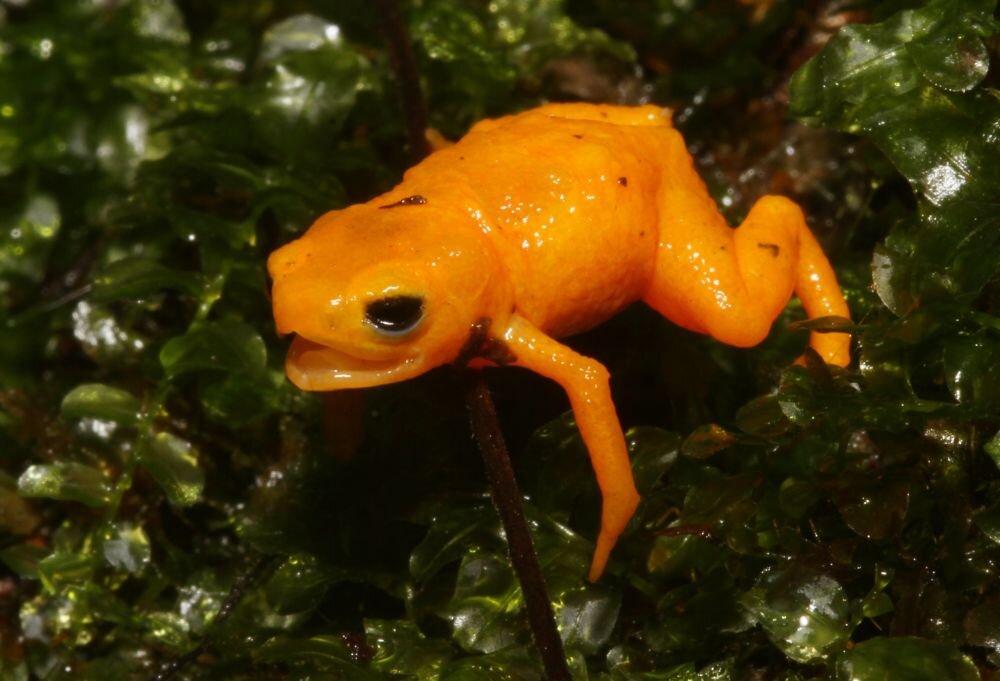It’s orange, fluorescent, and the size of a thumbnail. Meet the newly discovered amphibian Brachycephalus rotenbergae, a type of pumpkin toadlet found in Brazil’s Atlantic Forest.
The animal belongs to a family of at least 36 pumpkin toadlets, which are named after the popular Halloween squash. Like poison dart frogs, their vibrant color is likely a signal to predators that their skin carries a potentially deadly toxin.
The new species, described recently in the journal PLOS ONE, wasfound during an extensive research effort across Brazil to find new pumpkin toadlets. Identifying the creatures is crucial to conserving Brazil’s biodiversity, especially in species-rich areas such as the Atlantic Forest, which has lost 93 percent of its original cover due to deforestation and agriculture, experts say.
Brazil has the highest number of amphibian species in the world—at least a thousand—but amphibians worldwide are among the most vulnerable groups of vertebrates, particularly as the climate changes.
“The best moment to be a scientist is when you are looking at something new and you are the only person who knows,” says study leader Ivan Sergio Nunes Silva, a herpetologist at São Paulo State University.
“Unfortunately, nowadays, we are losing unidentified species faster than we can describe new ones.”
The tale of a new toadlet
Nunes and his team found B. rotenbergae during 76 field surveys between 2018 and 2019 in the 6,500-foot-high Mantiqueira Mountains, spending hours roaming rocky outcrops and streams that flow through the forests.
Back in the lab, the team took DNA samples of the new toad, and compared these with samples of known pumpkin toadlets. They also analyzed its physical features and bone structure, its behavior, and recordings of its mating calls to determine that it was a new species.
For instance, the new pumpkin toadlet is smaller than other known toadlets, with a more diminutive snout. Other unusual features include black, faded patterns on its skin and a preference for the Atlantic Forest’s higher elevations.
The creatures also cannot hear the sound of their own call because their ears are underdeveloped, Nunes says.
“Their communication is essentially visual,” he adds, since the frogs probably communicate by gaping their mouths.
Mysteriously, the amphibians also glow when placed under ultraviolet light, a wavelength they can see but humans can’t.Only two other pumpkin toadlet species are known to fluoresce, he adds.
Nunes and colleagues’ comprehensive approach—examining the amphibians’ physical bodies, genetics, and calls—is important, especially in the case of species that look alike, says Michel Varajao Garey, a professor at the Instituto Latino-Americano de Ciências da Vida e da Natureza, in Foz do Iguaçu, who was not involved in the research.
Such a thorough method can “reveal still unknown diversity,” he says, and possibly recategorize some species that were mislabeled.
In fact, until this study, B. rotenbergae was mistakenly categorized as the very similar-looking B. ephippium, the authors say—though this reclassification is also a source of controversy among some amphibian researchers.
For example, Rute Clemente-Carvalho, genomics lab manager at the Hakai Institute in British Columbia, Canada, isn’t convinced that B. rotenbergae is a new species, but is rather B. ephippium. For one, she says the genetic differences between B. ephippium and B. rotenbergae outlined in the study are very small.
In addition, the researchers did most of their genetic comparisons between B. rotenbergae and distantly related pumpkin toadlets, and not enough with B. ephippium samples to say it’s a new species, Clemente-Carvalho says by email.
